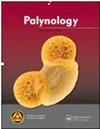Chemical processing of fossil phyllocarid cuticle: A comparison of micro- and macrofossil remains
IF 1.3
4区 地球科学
Q3 PALEONTOLOGY
引用次数: 0
Abstract
ABSTRACTCuticular remains of the phyllocarid crustaceans Caryocaris? and Ceratiocaris? obtained via maceration of macrofossil remains in hydrofluoric acid are compared with dispersed fragments isolated using both the low-manipulation HF extraction and the standard HCl–HF–HCl method. The studied specimens were obtained from Ordovician and Silurian shales of the Šárka and Požáry formations (Prague Basin, Barrandian area, Czech Republic). This methodological approach allows a direct comparison of macrofossil remains with microfossils in residue. The differences in residues obtained through the two bulk-rock extraction methods are also discussed.KEYWORDS: phosphatic microfossilsorganic-walled microfossilsextraction methodsearly PaleozoicPrague BasinDisclaimerAs a service to authors and researchers we are providing this version of an accepted manuscript (AM). Copyediting, typesetting, and review of the resulting proofs will be undertaken on this manuscript before final publication of the Version of Record (VoR). During production and pre-press, errors may be discovered which could affect the content, and all legal disclaimers that apply to the journal relate to these versions also. AcknowledgmentsThe authors would like to thank Ondřej Zicha (Prague) for providing specimens of Caryocaris and Saltericaris for the in situ study. We would further like to thank Monika Uhlířová and Zuzana Strossová (both Charles University Prague) for aid with collecting samples at Kosov quarry, Lena Kraus (Senckenberg Gesellschaft für Naturforschung) for assistance during laboratory processing of bulk rock samples from the Šárka Formation and Jana Čepičková (Charles University Prague) for providing literature, Lucy Muir for language editing, and finally to Vera Korasidis, Ben Slater and an anonymous referee for providing valuable feedback that significantly improved the manuscript.Disclosure statementNo potential conflict of interest was reported by the authors.FundingVK acknowledges support by the project “Grant Schemes at CU “(reg. no. CZ.02.2.69/0.0/0.0/19_073/0016935). OF acknowledges support by Cooperatio GEOL of the Ministry of Education, Youth and Sports of the Czech Republic.Figure 1 (A) Distribution of lower Paleozoic rocks within the Prague Basin and its location within the Czech Republic. (B) Stratigraphical subdivision of the Ordovician and Silurian of the Prague Basin with highlighted Šárka and Požáry formations (sampled in this study).Display full sizeFigure 2 Remains of Caryocaris? on a bedding plane (Ba, Ca, Da) and from microfossil residues (A, Bb, Cb, Db) placed upon a reconstruction. Scale bars represent 100 µm for all specimens except Cb. In Cb, the scale bar represents 50 µm.Display full sizePlate 1. Cuticular fragments of Caryocaris? sp. extracted (a) directly from macrofossil (2,7), (b) via ‘low-manipulation HF extraction’ process (4–6, 8–11, 13–18), (c) via HCl-HF-HCl processing (3) and a coniform conodont (12) from the locality Praha - Na Salátce quarry (Šárka Formation, Darriwilian, Middle Ordovician). Scale bars represent: 50 µm (1, 3, 4, 6, 8–10, 12, 14–16, 18); 200 µm (2); 100 µm (5, 7, 11, 17); 20 µm (13). Specimens 2, 7 were extracted directly from macrofossil, 1,4–6, 8–18 were extracted via the ‘low-manipulation HF extraction’ method, and specimen 3 was isolated using a standard palynological processing method.1. Slide ŠS–JEN–29b, EF: W42(3)2. Slide ŠS–JEN–Caryocaris_a, EF: V51(1)3. Slide ŠS–JEN–30a, EF: E394. Slide ŠS–JEN–29b, EF: E36(2)5. Slide ŠS–JEN–29b, EF: P30(4)6. Slide ŠS–JEN–29b, EF: Q64(4)7. Slide ŠS–JEN–Caryocaris_a, EF: R458. Slide ŠS–JEN–29b, EF: E54(3)9. Slide ŠS–JEN–29c, EF: B6410. Slide ŠS–JEN–29b, EF: O59(3)11. Slide ŠS–JEN–29b, EF: C53(4)12. Slide ŠS–JEN–29b, EF: H46(3)13.-18. Stub SAF_1Display full sizePlate 2. Remains of Ceratiocaris? sp. (1–3, 6, 7), unknown arthropod (9), and conodonts (4, 5) from the Kosov quarry (Požáry Formation, Přídolí, late Silurian). Scale bar represents: 400 µm (1,2), 100 µm (3), 50 µm (4–7). Specimens 1–3 were extracted directly from macrofossil, 4,5,8,9 extracted via the ‘low-manipulation HF extraction’ process and 6,7 using a standard palynological processing method.1. Slide PS-K-FY-1, EF: W48(3)2. Slide PS-K-FY-1, EF: K44(1)3. Slide PS-K-FY-1, EF: W47(1)4. Slide PS-K-L-6c, EF: G29(4)5. Slide PS-K-L-6b, EF: G38(3)6. Slide PS-K-8c, EF: K43(3)7. Slide PS-K-8c, EF: G39(2)8. Slide PS-K-L-2, EF: F38(4)9. Slide PS-K-L-4c, EF: N37(2)Display full size化石层状和角质层的化学加工:微观和宏观化石遗迹的比较
根茎类和甲壳类动物的表皮残骸?和Ceratiocaris吗?通过氢氟酸浸渍获得的大型化石遗骸与使用低操作HF萃取和标准HCl-HF-HCl方法分离的分散碎片进行了比较。研究样品取自捷克巴兰地地区布拉格盆地Šárka组和Požáry组奥陶系和志留系页岩。这种方法可以直接比较大化石和微化石的残留物。讨论了两种大块岩石提取方法所得到的残余量的差异。关键词:磷微化石有机壁微化石提取方法早期古生代布拉格盆地免责声明作为对作者和研究人员的服务,我们提供此版本的接受稿件(AM)。在最终出版版本记录(VoR)之前,将对该手稿进行编辑、排版和审查。在制作和印前,可能会发现可能影响内容的错误,所有适用于期刊的法律免责声明也与这些版本有关。作者要感谢Ondřej Zicha (Prague)为现场研究提供的Caryocaris和Saltericaris标本。我们还要感谢Monika Uhlířová和Zuzana strossov(布拉格查尔斯大学)在科索沃采石场收集样本的帮助,Lena Kraus (Senckenberg Gesellschaft f r Naturforschung)在实验室处理Šárka组的大量岩石样本时的帮助,Jana Čepičková(布拉格查尔斯大学)提供文献,Lucy Muir进行语言编辑,最后感谢Vera Korasidis。本·斯莱特(Ben Slater)和一位匿名审稿人,感谢他们提供了宝贵的反馈,极大地改进了手稿。披露声明作者未报告潜在的利益冲突。中大资助计划获“中大资助计划”(注册)资助。不。CZ.02.2.69/0.0/0.0/19_073/0016935)。论坛感谢捷克共和国教育、青年和体育部GEOL合作组织的支持。图1 (A)布拉格盆地下古生代岩石分布及其在捷克境内的位置。(B)布拉格盆地奥陶系和志留系地层划分,突出显示Šárka和Požáry组(本研究取样)。图2石雕的遗迹?在层理平面(Ba, Ca, Da)和微化石残留物(a, Bb, Cb, Db)上进行重建。除Cb外,所有样品的比例尺均为100µm。在Cb中,比例尺代表50µm。显示全尺寸板核caris的表皮碎片?sp. (a)直接从巨化石(2,7)中提取,(b)通过“低操作HF提取”过程(4,6,8 - 11,13 - 18),(c)通过HCl-HF-HCl处理(3)和在当地Praha - Na Salátce采石场(中奥陶统Darriwilian Šárka组)中提取的锥形牙形石(12)。比例尺表示:50µm (1,3,4,6,8 - 10,12,14 - 16,18);200µm (2);100µm(5、7、11、17);20µm(13)。2、7号标本直接从大化石中提取,1、4 ~ 6、8 ~ 18号标本采用“低操作HF提取”方法提取,3号标本采用标准孢粉处理方法分离。幻灯片ŠS-JEN-29b, EF: W42(3)2。滑动ŠS-JEN-Caryocaris_a, EF: V51(1)幻灯片ŠS-JEN-30a, EF: E394。幻灯片ŠS-JEN-29b, EF: E36(2)5。滑动ŠS-JEN-29b, EF: P30(4)6。幻灯片ŠS-JEN-29b, EF: Q64(4)7。幻灯片ŠS-JEN-Caryocaris_a, EF: R458。幻灯片ŠS-JEN-29b, EF: E54(3)9。幻灯片ŠS-JEN-29c, EF: B6410。幻灯片ŠS-JEN-29b, EF: O59(3)11。幻灯片ŠS-JEN-29b, EF: C53(4)12。幻灯片ŠS-JEN-29b, EF: H46(3)13 -18。Stub saf_1显示全尺寸板2。角龙的遗迹?sp.(1 - 3,6,7),未知节肢动物(9)和牙形刺(4,5),来自Kosov采石场(Požáry组,Přídolí,晚志留世)。比例尺表示:400µm(1,2), 100µm(3), 50µm(4-7)。标本1-3直接从大化石中提取,4、5、8、9采用“低操作HF提取”工艺提取,6、7采用标准孢粉处理方法提取。滑块PS-K-FY-1, EF: W48(3)2。滑块PS-K-FY-1, EF: K44(1)3。滑块PS-K-FY-1, EF: W47(1)4。滑块PS-K-L-6c, EF: G29(4)5。滑块PS-K-L-6b, EF: G38(3)幻灯片PS-K-8c, EF: K43(3)幻灯片PS-K-8c, EF: G39(2)8。滑块PS-K-L-2, EF: F38(4)幻灯片PS-K-L-4c, EF: N37(2)显示全尺寸
本文章由计算机程序翻译,如有差异,请以英文原文为准。
求助全文
约1分钟内获得全文
求助全文
来源期刊

Palynology
地学-古生物学
CiteScore
3.40
自引率
26.70%
发文量
48
审稿时长
>12 weeks
期刊介绍:
Palynology is an international journal, and covers all aspects of the science. We accept papers on both pre-Quaternary and Quaternary palynology and palaeobotany. Contributions on novel uses of palynology, review articles, book reviews, taxonomic studies and papers on methodology are all actively encouraged.
 求助内容:
求助内容: 应助结果提醒方式:
应助结果提醒方式:


